French Cleat Mounting System
How To Make And Use A French Cleat
The French Cleat mounting system has been around longer than anyone can remember.
Many think the name French Cleat originated from the 1800’s French shipbuilders who used the cleats to hang items on the ship walls to free up limited space on the ship’s floors or decks.
What is a French Cleat?
French cleats were originally made of interlocking wood wedges are used to hold an object securely, while still allowing for easy removal of that object.
The two interlocking pieces of wood [or metal] each with matching, interlocking 30–45-degree bevels. The two cleats are then connected together and held in place by its own weight. Once connected, they provide for easy and fast future removal or dismounting.
One French cleat is mounted to the wall and the other cleat is fastened to the object you want to hang. As a carpenter, French cleats allow me to spread out an object’s heavy weight across multiple wall studs.
French Cleat Uses
A French cleat is a strong, simple and inexpensive way to mount heavy objects or create a hidden, removable mount. They are often the strongest and easiest way to install items, such as:
- Heavy Art
- Cabinets
- Securing mirrors
- Securing radiator covers
- Hanging tools
- Hanging window and flower boxes
- Any object you want to hang
Use Plywood For The French Cleat
We recommend making your French cleats out of plywood vs. solid wood. Plywood resists splitting and is typically stronger.
The heavier the object the larger I make my cleat. On super heavy objects, I try to make the clean wide enough to get two structural screws in each wall stud.
Making the cleats are best done on a table saw. Start with a piece of plywood wider than needed. This allows you to cut the beveled edge first and later cut down the cleats to the desired widths.
How to Make a French Cleat Mounting System
- Set a table saw to 30-45 degrees and bevel-rip your plywood. [You will be using both beveled pieces.]
- Note: 30-45 degree bevel is a good bevel angle, the mating surfaces join on a “equally common plane, so the forces applied to both pieces of the cleat are fairly equal.
- Determine the cleat width and rip them to size, ensure that the bevel facing the table saw fence.

- Determine the area to hang your object; mark your center and determine height. In the photos you’ll notice a green laser line. I used the Bosch 360 laser to line art work with the seam of a french door on the opposite wall, in addition to the LED light that was going to illuminate the art.
- Note – I like to mark the centers of the wall, the cleat, and the item to be hung and reference them all during installation. Blue tape is useful for marking items that you don’t want to place a pencil mark on.

Securing The French Cleat To Wall
- Secure the wall French cleat. To make the installation easier, I mark the height on the wall first.
- Hold the cleat at that mark, then temporarily “tag” the cleat to the wall with a cordless finish nailer.
- Pivot the cleat, on that one nail, to level the cleat, and secure that with a second finish nail to temporarily hold the cleat level and in place.
Use the Correct Fasteners
- Attach the cleat to the wall, using appropriate fasteners.

- Consider the shear strength of your fasteners and compare that rating to the weight of the item being hung.
- Fasten the other cleat to the object being hung

Hanging the Object
- Hang item, slide item left or right to the position.
- Make your wall cleat slightly shorter than the object cleat. This allows the object to be shifted left and right slightly after it is hung, for centering or positioning.
After securing the cleat to the wall, the cabinet can be simply lifted onto it. French cleats do not require fine maneuvering, even a relatively heavy cabinet can be hung easily this way.
Don’t forget the Modern French Cleat – Metal Z-Clips
Z-Clips are typically made from aluminum and are a simple, strong and reliable way to hang almost any flat object on a wall. Z-clips are often referred to as Z rails, Z bars, Z hangers, all-aluminum French cleats work in essentially the same way as the original wood cleat.
One metal cleat is attached to the wall, and one – flipped the other way – is attached to the back of the item you want to hang. We used metal Z-clips to hang an upholstered headboard here.




















